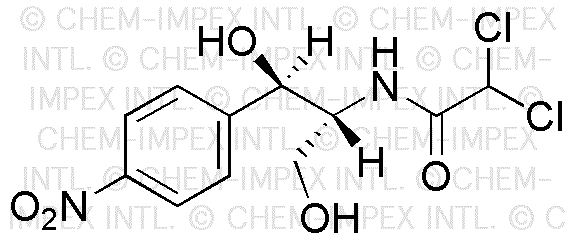Chloramphenicol is widely utilized in research focused on:
- Antibiotic Development: It serves as a crucial model for developing new antibiotics, particularly in studying bacterial resistance mechanisms.
- Veterinary Medicine: Commonly used to treat infections in animals, providing a vital option for veterinarians in managing bacterial diseases.
- Pharmaceutical Research: Employed in drug formulation studies, helping researchers understand the pharmacokinetics and pharmacodynamics of antibiotics.
- Laboratory Testing: Utilized in microbiological assays to test the efficacy of other antimicrobial agents, aiding in the development of new treatments.
- Clinical Applications: Effective in treating serious infections caused by specific bacteria, offering a reliable option for healthcare providers in critical care settings.
Informations générales
Propriétés
Sécurité et réglementation
Applications
Chloramphenicol is widely utilized in research focused on:
- Antibiotic Development: It serves as a crucial model for developing new antibiotics, particularly in studying bacterial resistance mechanisms.
- Veterinary Medicine: Commonly used to treat infections in animals, providing a vital option for veterinarians in managing bacterial diseases.
- Pharmaceutical Research: Employed in drug formulation studies, helping researchers understand the pharmacokinetics and pharmacodynamics of antibiotics.
- Laboratory Testing: Utilized in microbiological assays to test the efficacy of other antimicrobial agents, aiding in the development of new treatments.
- Clinical Applications: Effective in treating serious infections caused by specific bacteria, offering a reliable option for healthcare providers in critical care settings.
Documents
Fiches de données de sécurité (FDS)
La FDS fournit des informations de sécurité complètes sur la manipulation, le stockage et l’élimination du produit.
Spécifications du produit (PS)
Le PS fournit une description complète des propriétés du produit, notamment sa composition chimique, son état physique, sa pureté et les exigences de stockage. Il détaille également les plages de qualité acceptables et les applications prévues du produit.
Certificats d'analyse (COA)
Recherchez des certificats d'analyse (COA) en saisissant le numéro de lot du produit. Les numéros de lot et de lot se trouvent sur l'étiquette d'un produit, après les mots « Lot » ou « Lot de fabrication ».
Numéro de catalogue
Numéro de lot/série
Certificats d'origine (COO)
Ce certificat d'exploitation confirme le pays dans lequel le produit a été fabriqué, et détaille également les matériaux et composants utilisés et s'il est issu de sources naturelles, synthétiques ou autres sources spécifiques. Ce certificat peut être requis pour les douanes, le commerce et la conformité réglementaire.
Numéro de catalogue
Numéro de lot/série
Fiches de données de sécurité (FDS)
La FDS fournit des informations de sécurité complètes sur la manipulation, le stockage et l’élimination du produit.
DownloadSpécifications du produit (PS)
Le PS fournit une description complète des propriétés du produit, notamment sa composition chimique, son état physique, sa pureté et les exigences de stockage. Il détaille également les plages de qualité acceptables et les applications prévues du produit.
DownloadCertificats d'analyse (COA)
Recherchez des certificats d'analyse (COA) en saisissant le numéro de lot du produit. Les numéros de lot et de lot se trouvent sur l'étiquette d'un produit, après les mots « Lot » ou « Lot de fabrication ».
Numéro de catalogue
Numéro de lot/série
Certificats d'origine (COO)
Ce certificat d'exploitation confirme le pays dans lequel le produit a été fabriqué, et détaille également les matériaux et composants utilisés et s'il est issu de sources naturelles, synthétiques ou autres sources spécifiques. Ce certificat peut être requis pour les douanes, le commerce et la conformité réglementaire.

